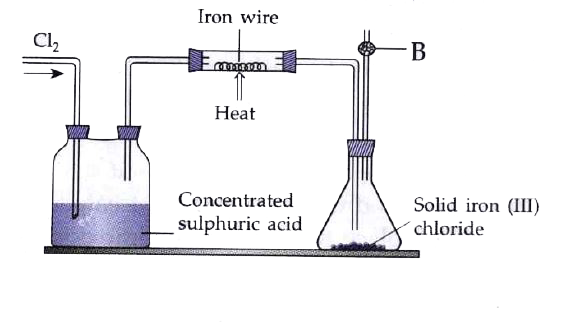Name :
a substance that will reduce aqueous Iron (III) ions to Iron (II) ions.
To answer the question of naming a substance that will reduce aqueous Iron (III) ions (Fe³⁺) to Iron (II) ions (Fe²⁺), we can follow these steps:
1. Understanding the Oxidation States:
- Iron (III) ions (Fe³⁺) are in a higher oxidation state compared to Iron (II) ions (Fe²⁺). To convert Fe³⁺ to Fe²⁺, we need a reducing agent that can donate electrons.
2. Identifying a Reducing Agent:
- A reducing agent is a substance that can lose electrons and thereby reduce another substance. In this case, we need a reducing agent that can effectively reduce Fe³⁺ to Fe²⁺.
3. Selecting Hydrogen Sulfide:
- One of the well-known reducing agents is hydrogen sulfide (H₂S). It has the ability to donate electrons and reduce Fe³⁺ ions to Fe²⁺ ions.
4. Chemical Reaction:
- When hydrogen sulfide reacts with iron (III) ions, the reaction can be represented as follows:
Fe3++H2S→Fe2++S+H+
- In this reaction, Fe³⁺ is reduced to Fe²⁺, while H₂S is oxidized to sulfur (S).
5. Conclusion:
- Therefore, the substance that will reduce aqueous Iron (III) ions to Iron (II) ions is Hydrogen Sulfide (H₂S).
- Iron (III) ions (Fe³⁺) are in a higher oxidation state compared to Iron (II) ions (Fe²⁺). To convert Fe³⁺ to Fe²⁺, we need a reducing agent that can donate electrons.
- A reducing agent is a substance that can lose electrons and thereby reduce another substance. In this case, we need a reducing agent that can effectively reduce Fe³⁺ to Fe²⁺.
- One of the well-known reducing agents is hydrogen sulfide (H₂S). It has the ability to donate electrons and reduce Fe³⁺ ions to Fe²⁺ ions.
- When hydrogen sulfide reacts with iron (III) ions, the reaction can be represented as follows:
Fe3++H2S→Fe2++S+H+
- In this reaction, Fe³⁺ is reduced to Fe²⁺, while H₂S is oxidized to sulfur (S).
- Therefore, the substance that will reduce aqueous Iron (III) ions to Iron (II) ions is Hydrogen Sulfide (H₂S).
Topper's Solved these Questions
- STUDY OF THE FIRST ELEMENT - HYDROGENBOOK - ICSECHAPTER - STUDY OF THE FIRST ELEMENT - HYDROGENEXERCISE - TOPIC 1 Hydrogen and its Laboratory Preparation (1 MARK QUESTIONS)
13 Videos
- STUDY OF THE FIRST ELEMENT - HYDROGENBOOK - ICSECHAPTER - STUDY OF THE FIRST ELEMENT - HYDROGENEXERCISE - TOPIC 1 Hydrogen and its Laboratory Preparation (2 MARK QUESTIONS)
24 Videos
- STUDY OF THE FIRST ELEMENT - HYDROGENBOOK - ICSECHAPTER - STUDY OF THE FIRST ELEMENT - HYDROGENEXERCISE - EXERCISE 6(C)
47 Videos
- STUDY OF GAS LAWS BOOK - ICSECHAPTER - STUDY OF GAS LAWS EXERCISE - TOPIC 2 (5 Marks Questions )
18 Videos
- THE LANGUAGE OF CHEMISTRYBOOK - ICSECHAPTER - THE LANGUAGE OF CHEMISTRYEXERCISE - EXCERCISE 1(C ) (Correct the following statement)
21 Videos
Similar Questions
Iron + sulphur → Iron(II) sulphide
View SolutionWhat is the formula of iron (III) sulphate?
View SolutionThe given diagram is to prepare Iron(III) chloride in the laboratory:
(i) What is substance B?
(ii) What is the purpose of B?
(iii) Why is iron(III) chloride to be stored in a closed container?
(iv) Write the equation for the reaction between iron and chlorine.

View SolutionGive the chemical tests between the following pairs:
Iron (II) sulphate and Iron (III) sulphate.
View SolutionName the ions obtained when HCl dissociates in aqueous solution .
View SolutionThe oxidation state of copper changes when aqueous copper (II) ions react with:
(I)NaOH(aq) (II)Fe(s) (III)KI(aq)
View SolutionThe oxidation state of copper changes when aqueous copper (II) ions react with:
(I)NaOH(aq) (II)Fe(s) (III)KI(aq)
View SolutionAn iron wire is immersed in a solution containing ZnSO4andNiSO4. When the concentration of each salt is 1 M, predict giving reactions which of the following reactions is likely to proceed : (i) Iron reduces Zn+ ions (ii) Iron reduces Ni2+ ions.
Given
EΘ=−0.76V for Zn2+/Zn
EΘ=−0.44V for Fe2+/Fe
EΘ=−0.25V for Ni2+/Ni
View SolutionThree faradays of electricity was passed through an aqueous solution of iron (II) bromide. The mass of iron metal (at mass 56) deposited at the cathode is:
View SolutionAn iron rod is immersed in a solution containing 1.0MNiSO4 and 1.0MZnSO4 Predict giving reasons which of the following reactions is likely to proceed ?
(i) Fe reduces Zn2+ ions,
(ii) Iron reduces Ni2+ ions.
Given : E0Zn2+∣Zn = -0.76 volt and ,E0Fe2+∣Fe = -0.44 volt and E0Ni2+∣Ni= -0.25 V
View Solution
